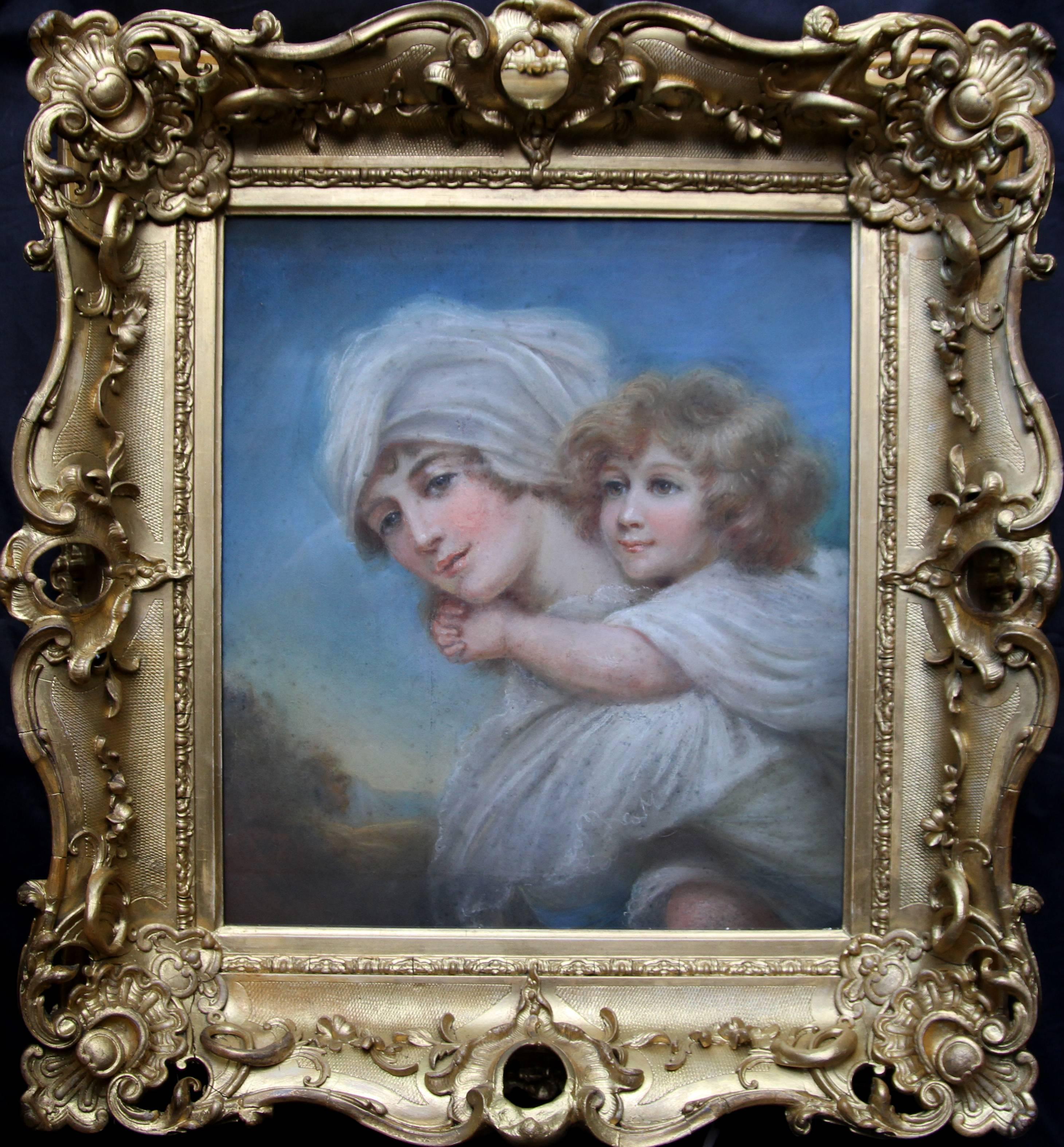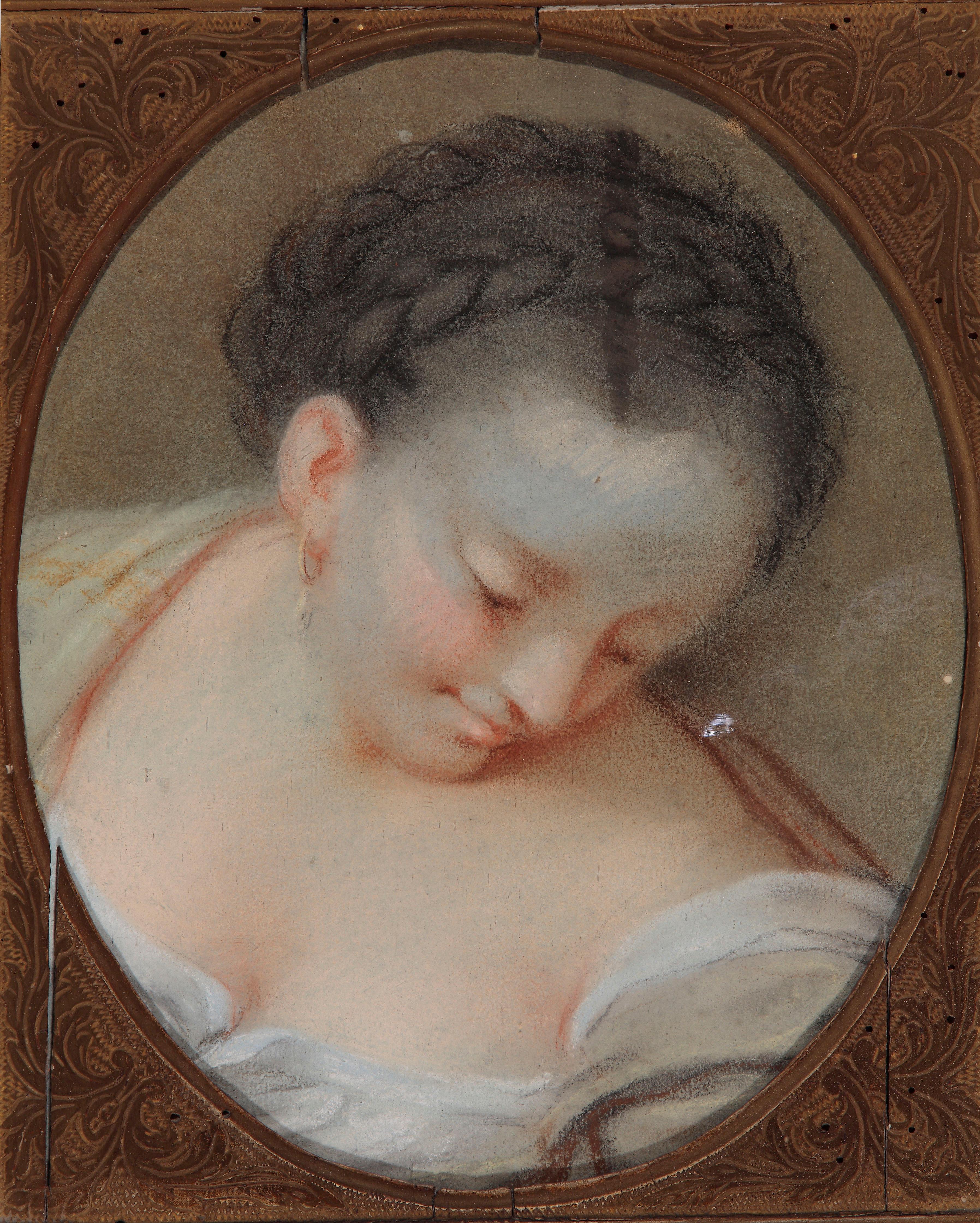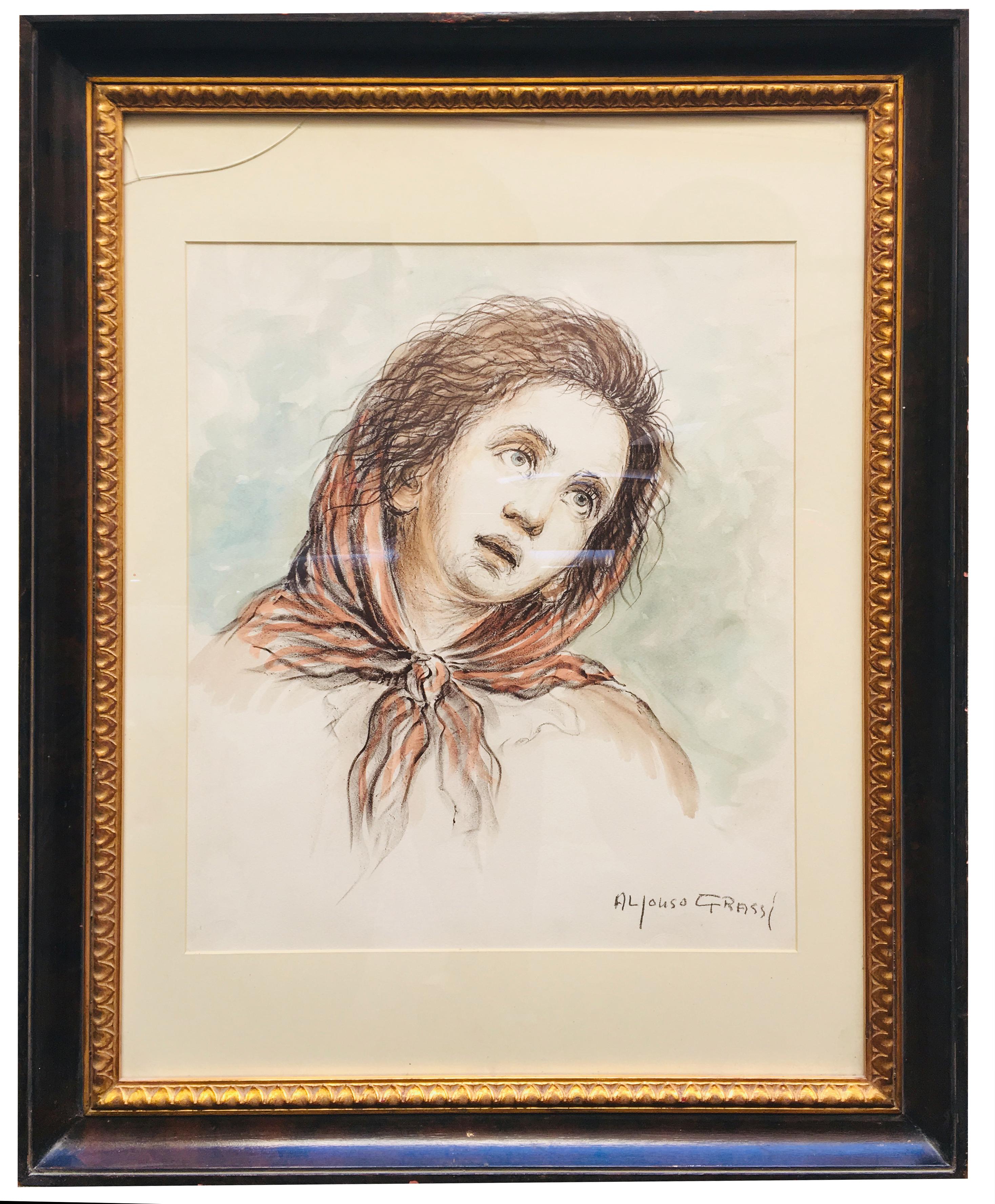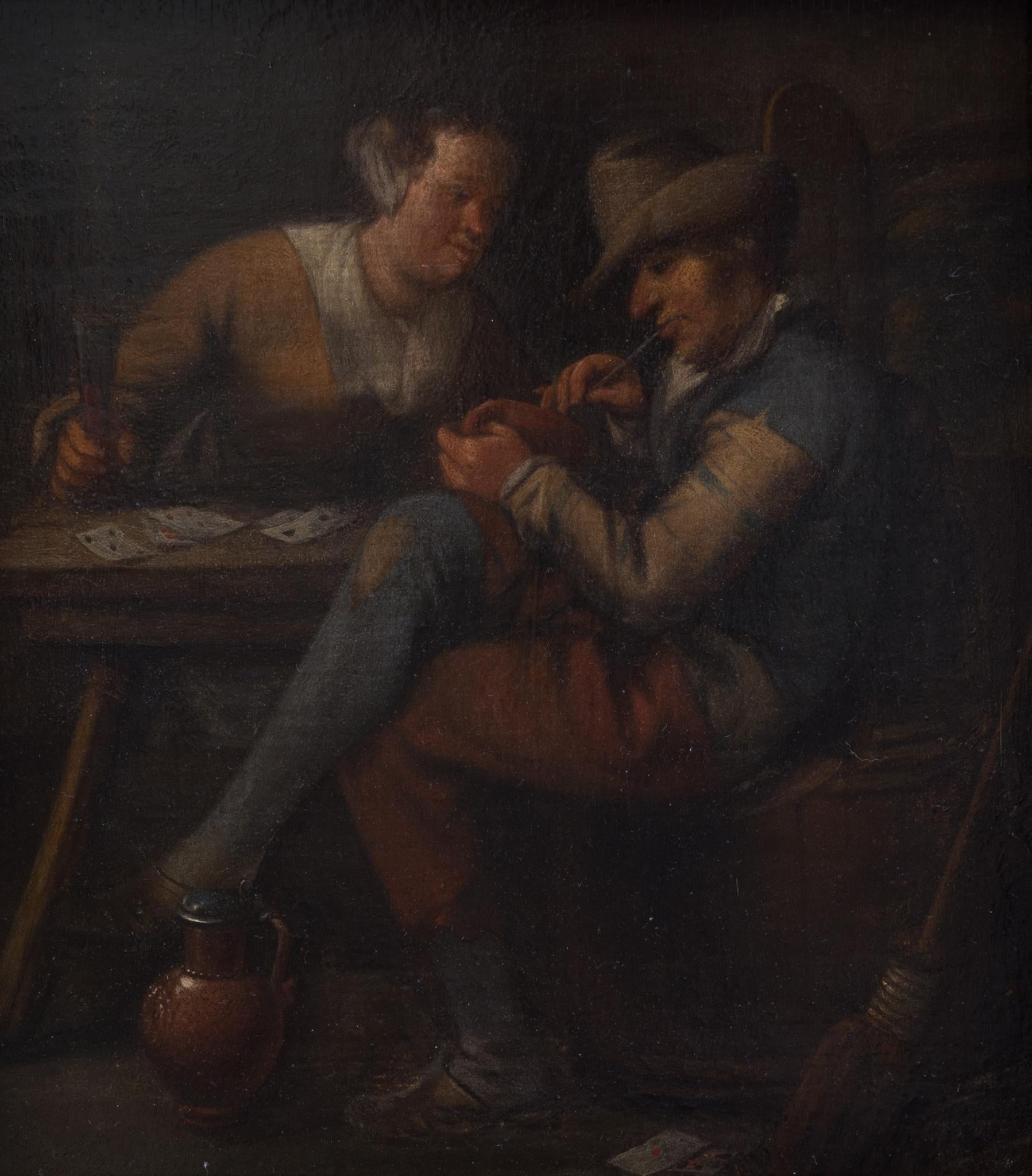Items Similar to Self-Portrait - Royal Academy Founding Member, 18th Century
Want more images or videos?
Request additional images or videos from the seller
1 of 3
Francis HaymanSelf-Portrait - Royal Academy Founding Member, 18th Century
About the Item
Francis Hayman RA
1708–1776
Self-Portrait
Oil on oak panel
Image size: 8 x 6¼ inches
Contemporary gilt frame
This newly discovered work is the earliest known self portrait by Francis Hayman, dated to the mid to late 1720’s. The small scale of the portrait gives it a strong sense of intimacy. Whereas clients would often dress themselves in their best clothes for a sitting, Hayman has portrayed himself in informal attire, with his shirt unbuttoned and a wig cap.
Born in 1708 to a respectable Devonshire family, his training began at the tender age of ten under the tutelage of the historical painter Robert Brown, who was probably an uncle. By the 1730’s he is known to have been engaged in painting scenery for the popular theatres on Goodman’s Fields and Drury Lane. He established a studio on St Martin’s Lane, and demonstrated his versatility as one of the most
important painters of his time in portraits, illustration and history painting.
Indeed, he was one of the first English painters deemed to have the skill and proficiency to rival that of the foreign masters, such as Holbein and Kneller, who were brought in by the court to make up for the perceived shortcomings of the native artists. Led by William Hogarth, Hayman and other artists began to create a new movement in the English art world. Thomas Gainsborough was one of his pupils, whom he is said to have introduced to the more lascivious and debauched underbelly of London life.
After mostly making his living as an illustrator, in the 1740’s Hayman was commissioned by the proprietor of the Vauxhall Pleasure Gardens, Jonathan Tyers, to produce a series of four large celebratory canvases depicting British victories from the Seven Years War. His association with Tyers continued, and over the next ten years he produced a number of large decorative paintings for the ornate supper boxes that were a very popular feature of the gardens.
Success as a portrait and conversation piece artist arose from his relaxed style, which cast aside the usual formal settings and poses to embrace the genteel environments of the urban middle classes in society, depicting their privileged life. These were often painted in the rococo style, which had become very popular in England in the early eighteenth century.
In 1768 Hayman is listed as a founding member of the Royal Academy, and rather ironically, given his rather wayward character, held the office of Academy Librarian from 1771 until his death in 1776. He is believed to have been married twice, although there is no surviving record of his first marriage.
Hayman died of gout in his house on Dean Street in Soho in February 1776. He is buried in an unmarked grave in nearby St Anne’s churchyard.
We are grateful to Professor Brian Allen, for confirming the attribution to Francis Hayman based on first hand examination of the work.
Literature:
- Allen, Brian, Francis Hayman, Yale University Press, (1987).
- Creator:Francis Hayman (1708 - 1776, British)
- Dimensions:Height: 8 in (20.32 cm)Width: 6.5 in (16.51 cm)
- Medium:
- Movement & Style:
- Period:
- Condition:
- Gallery Location:London, GB
- Reference Number:1stDibs: LU5246845362
About the Seller
5.0
Vetted Seller
These experienced sellers undergo a comprehensive evaluation by our team of in-house experts.
Established in 2007
1stDibs seller since 2014
64 sales on 1stDibs
Typical response time: 2 hours
- ShippingRetrieving quote...Ships From: London, United Kingdom
- Return PolicyA return for this item may be initiated within 3 days of delivery.
More From This SellerView All
- Portrait of a Girl, 17th Century English School Old Masters OilBy Gilbert JacksonLocated in London, GBGilbert Jackson English Active: 1620 - 1650 Portrait of a Girl Oil on panel, signed upper left and Inscribed upper right Image size: 24 ½ x 20 inches Contemporary style hand made...Category
17th Century Old Masters Portrait Paintings
MaterialsOil
- Portrait of William Herbert, 3rd Earl of Pembroke, Early 17th Century PortraitLocated in London, GBEnglish School, (circa 1600) Portrait of William Herbert, 3rd Earl of Pembroke Oil on panel, oval Image size: 29¼ x 23⅞ inches Painted wooden frame Provenance: 176, Collection of Francis Greville, 1st Earl of Warwick. The Trustees of the Lord Brooks’ Settlement, (removed from Warwick Castle). Sotheby’s, London, 22nd March 1968, lot 81. Painted onto wooden panel, this portrait shows a dark haired gentleman in profile sporting an open white shirt. On top of this garments is a richly detailed black cloak, decorated with gold thread and lined with a sumptuous crimson lining. With the red silk inside it’s all very expensive and would fall under sumptuary laws – so this is a nobleman of high degree. It’s melancholic air conforms to the contemporary popularity of this very human condition, evident in fashionable poetry and music of the period. In comparison to our own modern prejudices, melancholy was associated with creativity in this period. This portrait appeared in the earliest described list of pictures of Warwick castle dating to 1762. Compiled by collector and antiquary Sir William Musgrave ‘taken from the information of Lord & Lady Warwick’ (Add. MSS, 5726 fol. 3) is described; ‘8. Earl of Essex – an original by Zuccharo – seen in profile with black hair. Holding a black robe across his breast with his right hand.’ As tempting as it is to imagine that this is a portrait of Robert Devereux, the 2nd Earl Essex, we might take this with a pinch of salt. Its identification with this romantic and fatal Elizabethan might well have been an attempt to add romance to Warwick Castle’s walls. It doesn’t correspond all that well with Essex’s portraits around 1600 after his return from Cadiz. Notably, this picture was presumably hung not too far away from the castle’s two portraits of Queen Elizabeth I. The first, and undoubtedly the best, being the exquisite coronation portrait that was sold by Lord Brooke in the late 1970s and now hangs in the National Portrait Gallery. The second, described as being ‘a copy from the original at Ld Hydes’, has yet to resurface. The portrait eventually ended up being hung in the State Bedroom of Warwick Castle. Archival documents present one other interesting candidate. The Greville family’s earliest inventory of paintings, made in 1630 at their home Brooke House in Holborn, London, describes five portraits of identified figures. All five belonged to the courtier, politician and poet Sir Fulke Greville (1554-1628), 1st Baron Brooke, and were hung in the ‘Gallerie’ of Brooke House behind yellow curtains. One of them was described as being of ‘Lord of Pembrooke’, which is likely to have been William Herbert (1580-1630), 3rd Earl of Pembroke. William was the eldest son of Greville’s best friend’s sister Mary Sidney, and was brought up in the particularly literary and poetically orientated household which his mother had supported. Notably, the 3rd Earl was one of the figures that Shakespeare’s first folio was dedicated to in 1623. The melancholic air to the portrait corresponds to William’s own pretensions as a learned and poetic figure. The richness of the robe in the painting, sporting golden thread and a spotted black fabric, is indicative of wealth beyond that of a simple poet or actor. The portrait’s dating to around the year 1600 might have coincided with William’s father death and his own rise to the Pembroke Earldom. This period of his life too was imbued with personal sadness, as an illicit affair with a Mary Fitton had resulted in a pregnancy and eventual banishment by Elizabeth I to Wilton after a short spell in Fleet Prison. His illegitimate son died shortly after being born. Despite being a close follower of the Earl of Essex, William had side-stepped supporting Devereux in the fatal uprising against the Queen and eventually regained favour at the court of the next monarch James I. His linen shirt is edged with a delicate border of lace and his black cloak is lined on the inside with sumptuous scarlet and richly decorated on the outside with gold braid and a pattern of embroidered black spots. Despite the richness of his clothes, William Herbert has been presented in a dishevelled state of semi-undress, his shirt unlaced far down his chest with the ties lying limply over his hand, indicating that he is in a state of distracted detachment. It has been suggested that the fashion for melancholy was rooted in an increase in self-consciousness and introspective reflection during the late 16th and early 17th centuries. In contemporary literature melancholy was said to be caused by a plenitude of the melancholy humor, one of the four vital humors, which were thought to regulate the functions of the body. An abundance of the melancholia humor was associated with a heightened creativity and intellectual ability and hence melancholy was linked to the notion of genius, as reflected in the work of the Oxford scholar Robert Burton, who in his work ‘The Anatomy of Melancholy’, described the Malcontent as ‘of all others [the]… most witty, [who] causeth many times divine ravishment, and a kind of enthusiamus… which stirreth them up to be excellent Philosophers, Poets and Prophets.’ (R. Burton, The Anatomy of Melancholy, London, 1621 in R. Strong, ‘Elizabethan Malady: Melancholy in Elizabethan and Jacobean Portraits’, Apollo, LXXIX, 1964). Melancholy was viewed as a highly fashionable affliction under Elizabeth I, and her successor James I, and a dejected demeanour was adopted by wealthy young men, often presenting themselves as scholars or despondent lovers, as reflected in the portraiture and literature from this period. Although the sitter in this portrait is, as yet, unidentified, it seems probable that he was a nobleman with literary or artistic ambitions, following in the same vain as such famous figures as the aristocratic poet and dramatist, Edward de Vere...Category
Early 17th Century Old Masters Portrait Paintings
MaterialsWood Panel, Oil
- Portrait of Thomas Cromwell 1st Earl of Essex, English School 17th CenturyLocated in London, GBEnglish School 17th Century Portrait of Thomas Cromwell 1st Earl of Essex Oil on canvas Image size: 24 x 20 inches Giltwood decorated frame PROVENANC...Category
17th Century Old Masters Portrait Paintings
MaterialsOil
- PORTRAIT OF WILLIAM WARHAM, Old Masters Oil on WoodLocated in London, GBafter HANS HOLBEIN THE YOUNGER 1497 – 1543 PORTRAIT OF WILLIAM WARHAM Oil on canvas Image size: 38 x 35 inches (89 x 71 cm) Hand made period style frame The handling of the paint in...Category
18th Century and Earlier Old Masters Portrait Paintings
MaterialsOil, Canvas
- Portrait of a Girl, 18th Century Oil Old MasterBy George KnaptonLocated in London, GBGeorge Knapton 1698-1778 Portrait of a Girl Oil on canvas Image size: 20 x 18 inches Original giltwood frame This beautiful half length portrait of a young woman, turned to left, gazing at the spectator, wearing a pink, white lace-embroidered, dress, in her hair a pink bonnet trimmed with lace to match her dress. The depiction of a young girl epitomises child portraiture of the late eighteenth century, in which painters such as William Beechey, Joshua Reynolds, Thomas Gainsborough had begun to discover and express the true character of children, in contrast to the stiff, miniature-adults of previous generations. The Artist Knapton was born in Lymington, one of four sons of James Knapton. He was apprenticed to Jonathan Richardson from 1715 to 1722, and in 1720 was a founding subscriber to the academy of St. Martin's Lane established by Louis Chéron...Category
18th Century Old Masters Portrait Paintings
MaterialsOil, Canvas
- Portrait of a ManBy Cornelis DusartLocated in London, GBCircle of Cornelis Dusart Dutch 1660 - 1704 Portrait of a Man Oil on panel Image size: 7¾ x 5¼ inches Giltwood frame Cornelis Dusart Cornelis ...Category
17th Century Old Masters Portrait Paintings
MaterialsPanel, Oil
You May Also Like
- Woman and Child - Old Master Regency portrait painting Mother carrying infantLocated in London, GBA superb, large Regency circa 1820 portrait of the finest quality. It depicts a lovely young woman holding a child on her back. The portrait is framed behind glass in a magnificent d...Category
Early 19th Century Old Masters Portrait Paintings
MaterialsOil Pastel
- 17th-18th Century By Benedetto Luti Head of a Girl Oil Pastel on CanvasLocated in Milano, LombardiaOriginal "cassetta" frame in carved and gilded wood. Expertise by Prof. Giancarlo Sestieri.Category
18th Century Old Masters Portrait Paintings
MaterialsCanvas, Oil Pastel
- 17th-18th Century By Benedetto Luti Head of a Girl Oil Pastel on CanvasLocated in Milano, LombardiaOriginal "cassetta" frame in carved, gilded wood. Expertise by Prof. Giancarlo Sestieri.Category
18th Century Old Masters Portrait Paintings
MaterialsCanvas, Oil Pastel
- CHILD - Alfonso Grassi Pastel on paper Portrait italian PaintingBy Alfonso GrassiLocated in Napoli, ITCHILD - Pastel on paper cm.51x41 signed lower right by Alfonso Grassi, Italy. Wooden frame with passeportout cm.94x73Category
Late 20th Century Old Masters Portrait Paintings
MaterialsPastel, Paper
- The Card Players by a Flemish 1600s ArtistBy Flemish School, 17th CenturyLocated in Stockholm, SEFlemish 1600s School The Card Players oil on oak panel panel dimensions 22.5 x 20 cm frame included Provenance: From a Swedish private collection. Condition: Flat and stabl...Category
17th Century Old Masters Figurative Paintings
MaterialsOak, Oil, Panel
- "Eléa Ossified" (Abstract Portrait, Floral, Calming, Roses, Painting on Wood)By Nicholas EvansLocated in Paris, IDFELÉA OSSIFIED 2022 An abstracted portrait with detail of lying roses mimics thoughts caught in time, while capturing the complex notion of aging and beauty. A soft and calming paint...Category
2010s Abstract Paintings
MaterialsWood, Oil Pastel, Acrylic
Recently Viewed
View AllMore Ways To Browse
Antique Found
Artist Self Portrait
Life Size Portrait
England Portrait
New England Portraits
Large Scale Portrait
English Royal Painting
Antique Self
Royal Street
English 18th Century Art
Late 18th Century Royal
Oil Royal England
Francis First
18th Century New England
Old England 18th Century
Old English 18th Century
Early Eighteenth Century
18th Century England Painting





